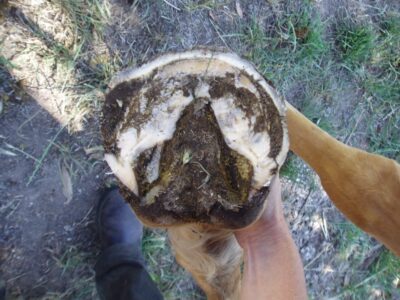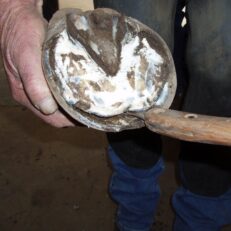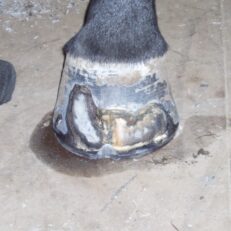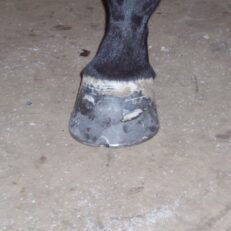The cause, the effect and the resolution of Seedy Toe – also known as White Line Disease.
THE CAUSE:
It seems that weather conditions play a big part in the cause of Seedy Toe – lots of rain followed by warm days and good spring grass growth.
These three things promote rapid hoof growth and very often that hoof growth can get way ahead of the maintenance trimming schedules; not only are the hooves growing fast but they are also quite soft and very flexible. The end result is flaring of the hoof wall, which causes it to separate from the laminae at the junction of the white line, hence the term White Line Disease (Pic 1). This condition allows dirt and foreign materials to be pushed up into that area of the sensitive tissue under the hoof wall which then causes aggravation, then inflammation, then infection followed by an abscess.
Horses in flooded areas have even more problems with Seedy Toe if they cannot be moved to higher ground or into dry stabling or if the water is too deep for them to wear boots.

THE EFFECT:
The effect is always lameness, associated with heat in the hoof wall and a much stronger digital pulse than normal.
Sometimes the infection will migrate under the sole and erupt back out near the heels or alongside the frog, or sometimes the abscess will make a track upwards through the laminae and erupt out at the coronary band.
When these abscesses have been resolved there is a capillary track left under the hoof wall; this is where the microscopic Seedy Toe bug develops, which thrives in this closed area where there is no oxygen as it is an anaerobic bug (ie thrives on lack of air) and eats away the laminae under the hoof wall resulting in a cavity. Left unresolved, Seedy Toe has the potential to cause the whole hoof capsule to separate from the pedal bone, or put simply to drop off.
When the abscess infection runs back under the sole it does not progress into Seedy Toe; the reason is that the sole continually exfoliates and does not have a lamellar structure for the Seedy Toe bug to harbour in. However with an under-run infection from an abscess that has started from hoof wall separation at the white line area, part of or all of the sole and often the frog will lift off after the infection has passed and it may take two or three months to normalise.
THE RESOLUTION:
Resolving Seedy Toe requires the intervention of professional vet and farrier team plus full cooperation of the owner, and full knowledge of what causes Seedy Toe and how to control it and prevent it from reoccurring.
We must understand that a flare anywhere in the hoof wall is your greatest enemy at any time but more especially right now, when everything is soft and flexible.
Treatment should be to remove or debride all the separated hoof wall (Pic 2) back to where there is no more visible parting of the laminae/white line/hoof wall and the area should then be left open to the air for a couple of weeks, which is time enough to kill the anaerobic Seedy Toe bug; it will have only been active up around the outer edges of the opening now exposed or debrided, so in an example such as this (Pic 3), you may need to fit a supporting shoe and rebuild stability to the lower part of the hoof wall (Pic 4), then the horse can be worked normally while the hoof eventually grows down and grows back to normal.
Over the years there have many and varied remedies for Seedy Toe or White Line Disease discussed by many people, and we will each use the remedy we have the most faith with. Peroxide, blue stone or condy’s crystals are all bandaids and are all totally useless at preventing Seedy Toe and can also prevent the proper bonding of hoof reconstruction materials which can be needed in extreme cases of Seedy Toe.
We would never have to deal with Seedy Toe if we just learned to recognise its cause rather than looking for bandaids after the problem arises. The one cure for the anaerobic Seedy Toe bug is exposure to air.
PREVENTION: There is one principle that is undeniable and it is that ‘prevention is better than cure’.
Correct balance in the hoof eliminates flares anywhere in the hoof wall, which prevents cracks and separation from developing, and we should then be able to maintain a sound hoof, whether shod or unshod.



